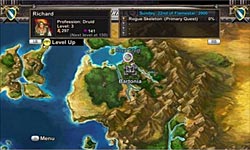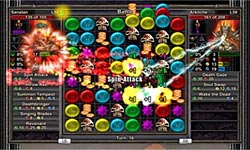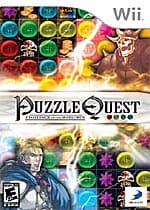Puzzle Quest, Again
Many would argue, and rightly so, that the puzzle genre has gotten rather stale over the past several years. Yes, the Nintendo DS has given the opportunity for some great puzzle games, but the genre hasn’t seen much action recently. But around a year ago, the genre received a breath of fresh air with the release of Puzzle Quest: Challenge of the Warlords on both the Nintendo DS and Sony PSP. Its formula for success? Combine two classic genres — puzzle and RPG — to create an unprecedented game.

Given the game’s overwhelming success, it’s no surprise that it began to expand and come to other consoles. And now, at last, Puzzle Quest: Challenge of the Warlords is here. Sony’s PS3 is now the only main console on the market not to feature this title, and though it has some significant flaws, I’ve got to admit that the PS3 is missing out on one heck of a game.
This game is a great mix of puzzle and role-playing elements, so let’s start with the puzzle aspect of the game. For the most part, this game plays out entirely as a Bejeweled-esque puzzle game. The idea is to align rows or columns of three or more like-colored jewels by pointing the Wii Remote at a jewel and pointing to an adjacent space where you want to move it. When you do this, these lined-up jewels will disappear, and more jewels will fall down to take their place. Oftentimes, this “cascading” effect leads to more combinations being formed. If you manage to rack up rows or columns of four or even five like-colored jewels, you’ll be rewarded with an extra turn.
It may sound a lot like a title like Meteos, but it’s not, thanks to one significant caveat with the gameplay system. See, you’re only allowed to move one jewel one adjacent spot (and diagonal moves are illegal) in order to create a row or column of three or more jewels. The jewel that you move must create a column or row of three or more; otherwise, this is deemed an illegal move, and you are punished. This implementation keeps the gameplay well-paced and keeps it from getting too simple.

But what’s the point? What does aligning jewels do for you in the game? Well, that’s where the role-playing elements of Puzzle Quest come into the mix. In addition to there being jewels on the playing field, there are also skulls and purple stars. When you make stars disappear, they give you experience, allowing your attacks to be more powerful. The skull icons on the board, when lined up, cause physical damage to your opponent.

The amount of damage done by your attacks is also determined by another RPG convention: equipment. You’re not the only one dishing out damage; your opponent also gets a turn to line up jewels, and you can be injured as well. Finding shields throughout the game — by winning battles or by purchasing them in shops — can help cut down on how much you’re hurt by enemy attacks. Similarly, purchasing a stronger weapon will help you to do more damage in battle.
However, lining up skulls is not going to be the primary way that you deal damage as you progress further and further into the game. Each specific class of character (more on that later) has their own unique spells. When you line up three red jewels, you will receive “red mana” — each spell requires a certain amount of each type of mana to be cast. Once you’ve met this requirement, you can unleash an often-devastating attack on your opponent, which is far more effective then trying to deal damage by lining up skulls.
And trust me, you’re going to need all the damage you can deal. Even from the beginning, Puzzle Quest is a very tough game — sometimes annoyingly so — and the difficulty curve is quite steep. The game gives you a bit of guidance as to how to succeed in battle, but the majority of getting good at this game relies on you playing enough to really get good at seeing the opportunity for combinations. And then, once you place a time limit on each move (ranging from 15 to 3 seconds) you’re really going to need an eye for setting up combos.

In fact, as you progress more and more into the game, the enemies seem to be downright unfairly suited. They have a lot of HP, and the mechanic seems to be playing in their favor — they constantly get well-placed jewels and have a frustrating knack for setting up huge combos. And while it’s immensely frustrating at first, the difficulty actually comes as a bit of a “breath of fresh air”, especially considering the slew of pathetically easy DS games on the market right now.
There are also some more advanced aspects to this game that really don’t occur until you get well into it. For example, you’ll start gaining battle partners, and you can even conquer cities that are under enemy control. At this point, the game almost seems to be a bit overambitious, and while this is a very neat idea, you’ve got to realize that at its core, this title is essentially a very well dressed puzzle game.
Holding all this together is one final popular RPG convention: a plot. While it follows along a very overdone fantasy theme, it’s pretty enjoyable. However, the plot is where the game gets into a bit of trouble. The story itself is fine with me, but what I absolutely could not stand was the incredibly miniscule text that’s present throughout the entire game. I’ve got good eyesight and like to read, and yet I found myself actually skipping through portions of the text because I just couldn’t stand to get three inches away from the TV screen and try and decipher what the words on the screen were. I don’t know what on Earth happened, but the small text — a very unorthodox problem — really detracts from the storyline, solely because it may cause you to completely ignore it.
Still, if you can get over that and appreciate the puzzle and role-playing elements that Puzzle Quest has to offer, you’ll likely have a lot of fun with this game. Additionally, this title sports tons of replay value. Previously, I briefly alluded to character classes. There are four different classes: warrior, knight, druid, and wizard. The class that you choose at the beginning of the game will greatly affect the way that you play. Each class has very distinct spells, and it’s actually really fun to play through the entire game with each different class. Trust me: there’s TONS of replay value here.
Graphically, Puzzle Quest isn’t all that impressive. The visuals are naturally crisper and nicer-looking than the DS version of the game, but that’s something that I would certainly expect from a Wii title. The game looks fine, really, and puzzle games don’t need to have brilliant visuals for it to work. Sure, the game’s graphics aren’t the best, but the game really doesn’t suffer at all because of it.
Finally, there’s a surprisingly fun multiplayer offering to be had with Puzzle Quest. It plays out just about identically to the single-player quest mode, except for the fact that, obviously, you’re facing off against a friend rather than a computer opponent. Puzzle Quest is one of those games that is actually a lot more fun to play with a friend than by yourself, so the multiplayer offering is definitely worth checking out.
Puzzle Quest is by no means perfect. In fact, one of its most noticeable flaws happens to be an extremely weird one (tiny text) and immensely frustrating, and the game may not be good for casual gamers due to its high difficulty level. Still, if you can get over both those flaws, you’re in for one heckuva good time. Puzzle Quest is addictive, exciting, and features some excellent multiplayer. What’s not to like?
Features:
RATING OUT OF 5 RATING DESCRIPTION 3.0 Graphics
They’re not bad, but they’re not that impressive either. Still, though, the game doesn’t suffer because of it. 4.0 Control
The Wii controls aren’t incredibly innovative, but they work pretty well. There are a few little flukes here and there, but the more you play, the better you’ll get at the pointing and clicking. 4.0 Music / Sound FX / Voice Acting
The little voice over that’s present is good; the music is not incredibly memorable, but it’s still pretty good. 4.6
Play Value
The game is plenty of fun, and the multiple character classes provide plenty of reason to play through the game multiple times.
4.1 Overall Rating – Great
Not an average. See Rating legend above for a final score breakdown.
